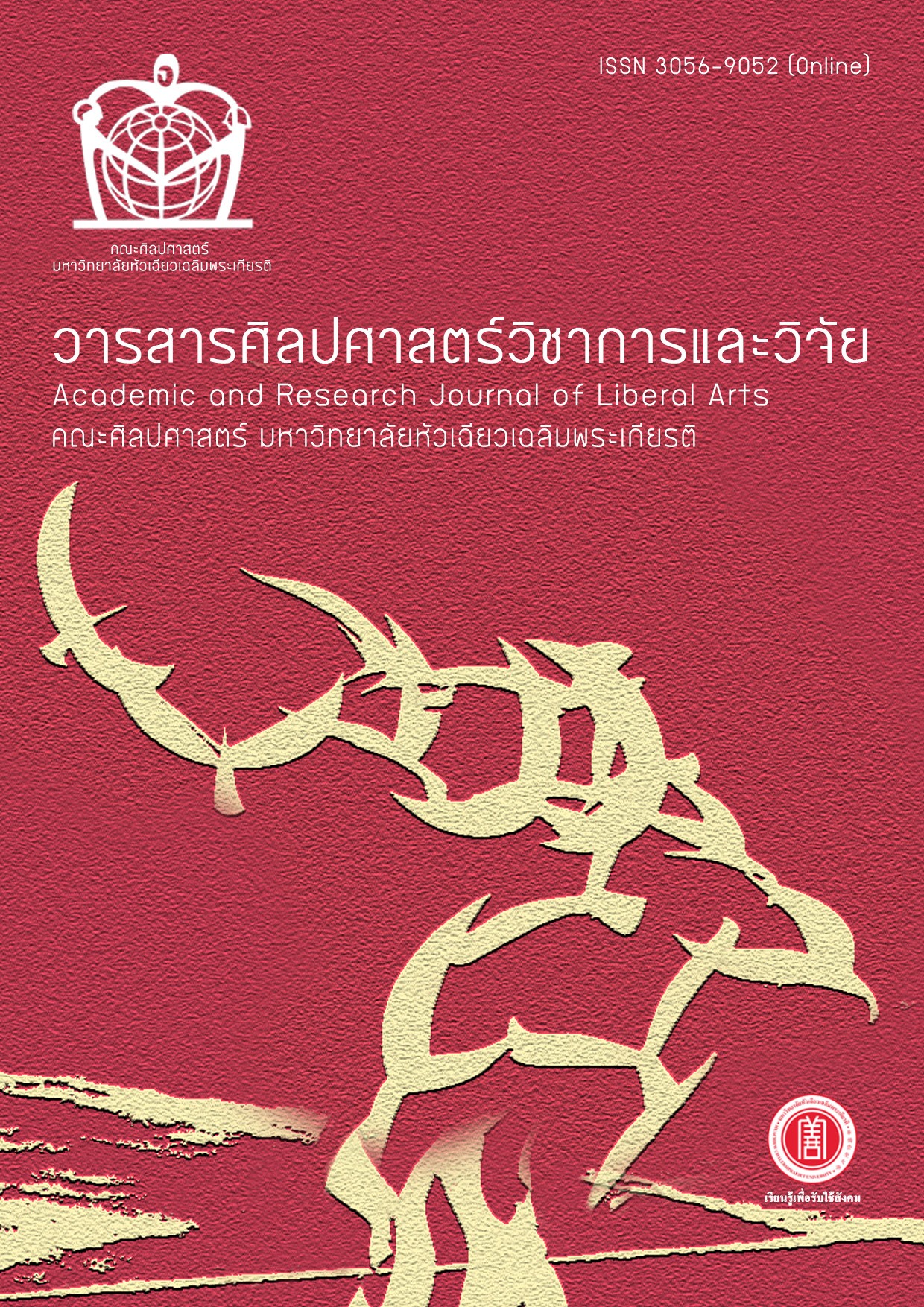Acoustic Phonetic Analysis of Thai Language Tones by Chinese Learners: A Case Study at Nanjing Tech University Pujiang Institute
DOI:
https://doi.org/10.14456/arjla.2024.7Keywords:
Thai Language Tones, Acoustic Phonetics, Chinese Learners, Fundamental Frequency Analysis, Tone VariationAbstract
This research aims to analyze the acoustic-phonetic attributes of Thai language tones as articulated by 20 Chinese students, who are majoring in Thai at the Nanjing Tech University Pujiang Institute. The data collection employed 25 Thai words, curated to evaluate the articulation of the five distinct Thai tones across a range of initial consonant scenarios, incorporating both dead and live syllables. The fundamental frequency measurements were conducted using Praat software version 6.1.29. Findings reveal that the neutral tones, notably the mid and low tones, were generally produced accurately, corresponding to the phonetic tone values [32] and [21] respectively. Contrarily, the contour tones presented some discrepancies: the falling tone was produced with values [42] and [31], deviating below the norm. The high tone was varied, with values [323], [324], [325], [434], and [435], exhibiting inconsistency in the rise and fall patterns when compared to standard tones, with these variations present in half of the sampled data. The rising tone, however, was rendered with a value of [212], closely mirroring the normative pattern, though the initial point was frequently elevated, as denoted by [312], [313], [423], and [433]. In summary, the study unveils a propensity among Chinese students to deviate from standard Thai tone production, potentially influenced by their native linguistic backgrounds, specifically Sinan dialect and Mandarin.
References
กมลทิพย์ ห่อเพชร. (2544). การเปรียบเทียบเสียงวรรณยุกต์ในคำภาษาไทยมาตรฐานที่พูดโดยกลุ่มชาติพันธุ์ ไทย มลายูและจีนในตำบลสะเดาและตำบลสำนักแต้ว อำเภอสะเดา จังหวัดสงขลา (วิทยานิพนธ์ปริญญามหาบัณฑิต). มหาวิทยาลัยทักษิณ, สงขลา.
กาญจนา นาคสกุล. (2541). ระบบเสียงภาษาไทย. กรุงเทพมหานคร: โครงการตำราคณะอักษรศาสตร์ ลำดับที่ 38 จุฬาลงกรณ์มหาวิทยาลัย.
จรัสศรี จิรภาส. (2562). “ศึกษาไทย”และ “ไทยศึกษา” ในประเทศจีน. วารสารภาษาและวัฒนธรรม, 38(2), 95-118.
ชมนาด อินทจามรักษ์. (2560). วรรณยุกต์ภาษาไทยที่ออกเสียงโดยผู้พูดภาษามีวรรณยุกต์และผู้พูดภาษาไม่มีวรรณยุกต์: การศึกษาทางกลสัทศาสตร์. วารสารมนุษยศาสตร์, 20(2), 1-26.
ธนภัทร สินธวาชีวะ. (2552). วรรณยุกต์ภาษาไทยกรุงเทพที่ออกเสียงโดยคนญี่ปุ่น. วารสารภาษาและภาษาศาสตร์, 28(1), 74-90.
ธีระพันธ์ ล. ทองคำ และนิสิตบัณฑิตศึกษา. (2554). เสียงภาษาไทย: การศึกษาทางกลสัทศาสตร์. กรุงเทพมหานคร: จุฬาลงกรณ์มหาวิทยาลัย.
ผณินทรา ธีรานนท์. (2563). กลสัทศาสตร์และโสตสัทศาสตร์เสียงวรรณยุกต์ภาษาไทยโดยชาวเวียดนามและชาวกัมพูชา. วารสารภาษาและวัฒนธรรม, 35(1), 81-100.
วิไลลักษณ์ จูวราหะวงศ์. (2543). วรรณยุกต์ภาษาไทยกรุงเทพฯ ที่พูดโดยคนไทย คนแต้จิ๋ว คนซิกข์ (วิทยานิพนธ์ปริญญามหาบัณฑิต). จุฬาลงกรณ์มหาวิทยาลัย, กรุงเทพมหานคร.
ศรีวิไล พลมณี. (2545). พื้นฐานการสอนภาษาไทยในฐานะภาษาต่างประเทศ. กรุงเทพมหานคร: สำนักพิมพ์แห่งจุฬาลงกรณ์มหาวิทยาลัย.
ศุจิณัฐ จิตวิริยานนท์. (2555). การปรับค่าความถี่มูลฐานโดยการแปลงค่าเฮิรตซ์เป็นเซมิโทน: แนวทางในการเสนอผลการวิเคราะห์วรรณยุกต์. The Journal of the Faculty of Arts, 8(2), 19-45.
Henderson, E. J. (1963). The Vowels and Tones of Standard Thai: Acoustical Measurements and Experiments.International Journal of American Linguistics, 28(2), 1-26.
Ding & Rong. (2012). A Course for Mandarin Chinese Pronunciation. Beijing: Peking University Press.
Fang, H. (2021). Study on The Phonetic Variation of Dialects in the transition zone between zhongyuan mandarin and southwest mandarin. Shanghai: Degree of Master in arts Chinese Linguistics and Philosophy Shanghai International Studies University.
Morén, B., & Zsiga, E. (2006). The lexical and post-lexical phonology of Thai tones. Natural Language & Linguistic Theory, 24(1), 113-178.
Teeranon, P. (2020). Thai tones in Chinese students after using the “Tone Application”and their attitudes. Journal of Language and Linguistic Studies, 16(4), 1680-1697.
Thepboriruk, K. (2009). Bangkok Thai Tones Revisited. University of Hawai‘i at Ma ̅noa Working Papers in Linguistics, 40(5), 1-17.
李如龙. (2003). 汉语方言的比较研究.北京:商务印书馆.
Downloads
Published
How to Cite
Issue
Section
License
Copyright (c) 2024 Liberal Arts Review

This work is licensed under a Creative Commons Attribution-NonCommercial-NoDerivatives 4.0 International License.
บทความที่ได้รับการตีพิมพ์เป็นลิขสิทธิ์ของวารสารศิลปศาสตร์วิชาการและวิจัย
ข้อความที่ปรากฏในบทความแต่ละเรื่องในวารสารวิชาการเล่มนี้เป็นความคิดเห็นส่วนตัวของผู้เขียนแต่ละท่านไม่เกี่ยวข้องกับมหาวิทยาลัยหัวเฉียวเฉลิมพระเกียรติ และคณาจารย์ท่านอื่นๆ ในมหาวิทยาลัยฯ แต่อย่างใด ความรับผิดชอบองค์ประกอบทั้งหมดของบทความแต่ละเรื่องเป็นของผู้เขียนแต่ละท่าน หากมีความผิดพลาดใดๆ ผู้เขียนแต่ละท่านจะรับผิดชอบบทความของตนเองแต่ผู้เดียว




